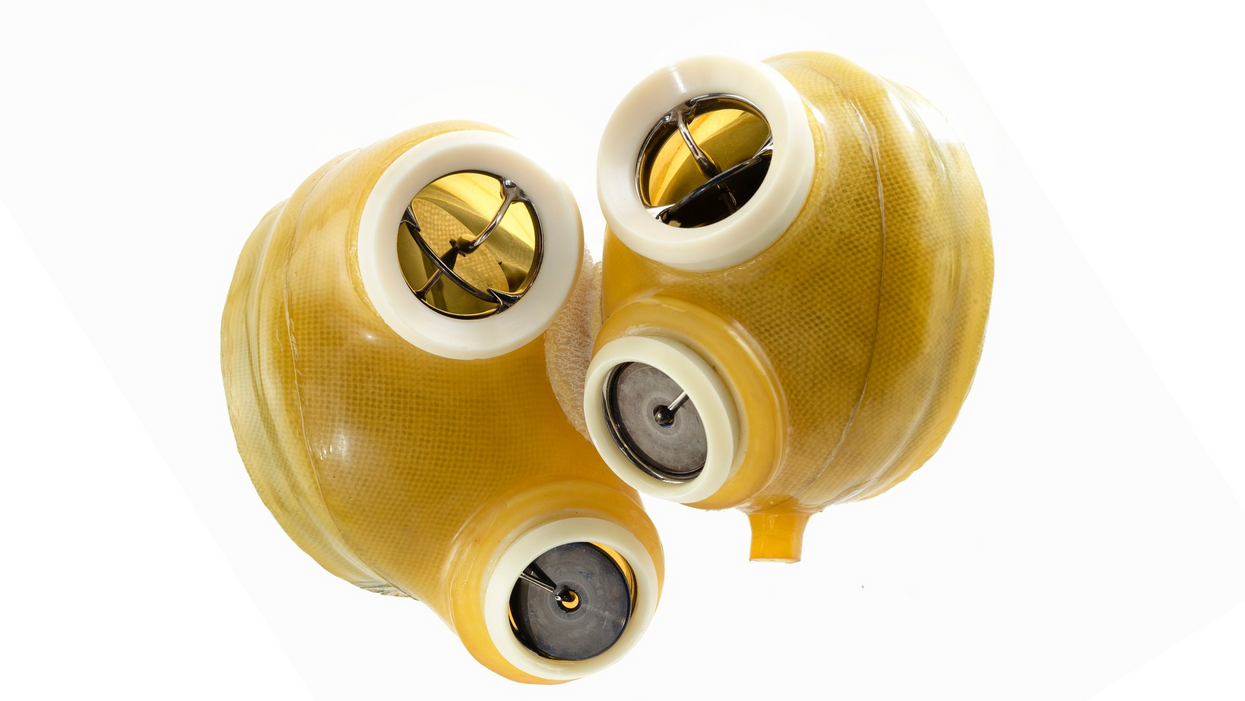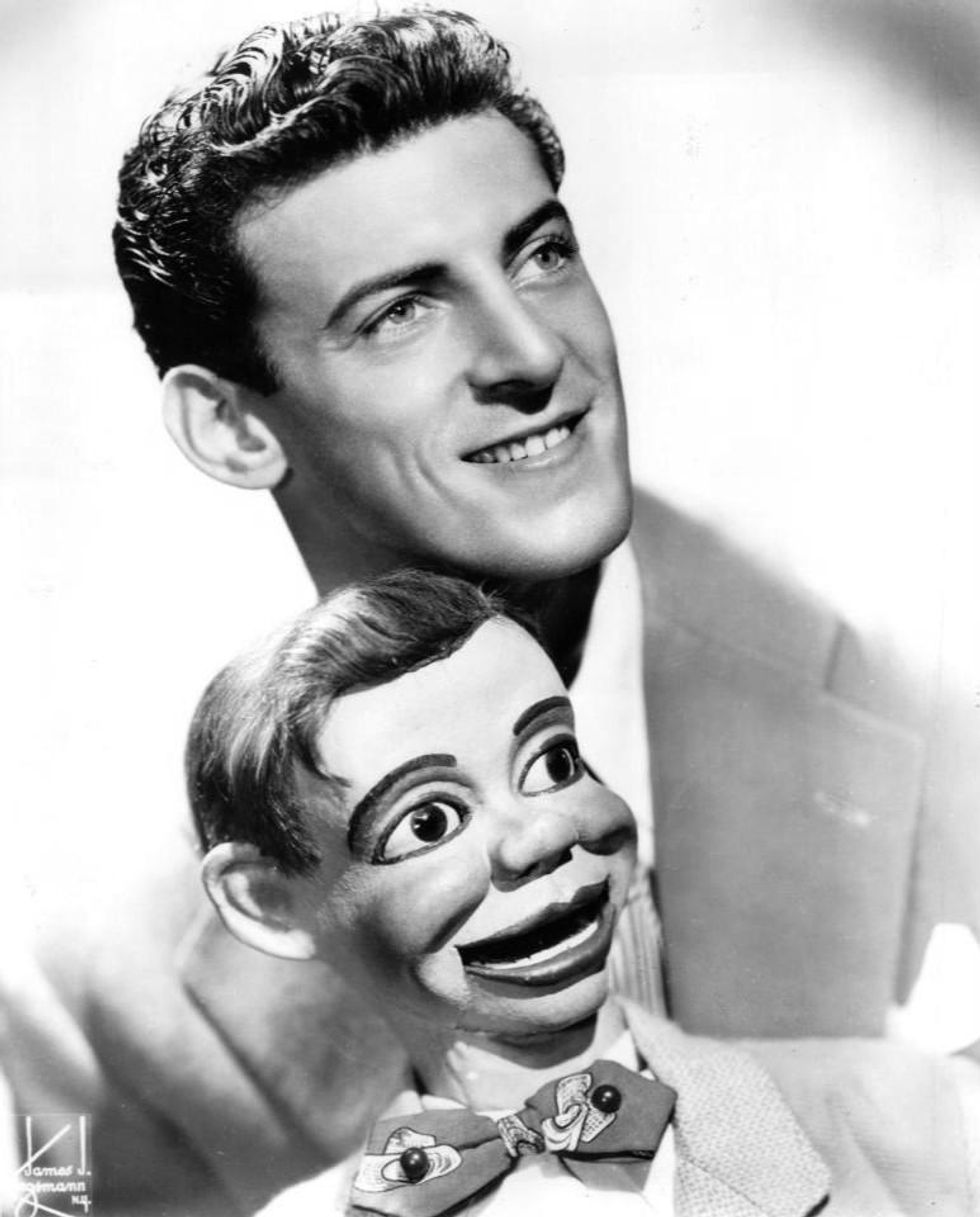The Voice Behind Some of Your Favorite Cartoon Characters Helped Create the Artificial Heart

This Jarvik-7 artificial heart was used in the first bridge operation in 1985 meant to replace a failing heart while the patient waited for a donor organ.
In June, a team of surgeons at Duke University Hospital implanted the latest model of an artificial heart in a 39-year-old man with severe heart failure, a condition in which the heart doesn't pump properly. The man's mechanical heart, made by French company Carmat, is a new generation artificial heart and the first of its kind to be transplanted in the United States. It connects to a portable external power supply and is designed to keep the patient alive until a replacement organ becomes available.
Many patients die while waiting for a heart transplant, but artificial hearts can bridge the gap. Though not a permanent solution for heart failure, artificial hearts have saved countless lives since their first implantation in 1982.
What might surprise you is that the origin of the artificial heart dates back decades before, when an inventive television actor teamed up with a famous doctor to design and patent the first such device.
A man of many talents
Paul Winchell was an entertainer in the 1950s and 60s, rising to fame as a ventriloquist and guest-starring as an actor on programs like "The Ed Sullivan Show" and "Perry Mason." When children's animation boomed in the 1960s, Winchell made a name for himself as a voice actor on shows like "The Smurfs," "Winnie the Pooh," and "The Jetsons." He eventually became famous for originating the voices of Tigger from "Winnie the Pooh" and Gargamel from "The Smurfs," among many others.
But Winchell wasn't just an entertainer: He also had a quiet passion for science and medicine. Between television gigs, Winchell busied himself working as a medical hypnotist and acupuncturist, treating the same Hollywood stars he performed alongside. When he wasn't doing that, Winchell threw himself into engineering and design, building not only the ventriloquism dummies he used on his television appearances but a host of products he'd dreamed up himself. Winchell spent hours tinkering with his own inventions, such as a set of battery-powered gloves and something called a "flameless lighter." Over the course of his life, Winchell designed and patented more than 30 of these products – mostly novelties, but also serious medical devices, such as a portable blood plasma defroster.

| Ventriloquist Paul Winchell with Jerry Mahoney, his dummy, in 1951 |
A meeting of the minds
In the early 1950s, Winchell appeared on a variety show called the "Arthur Murray Dance Party" and faced off in a dance competition with the legendary Ricardo Montalban (Winchell won). At a cast party for the show later that same night, Winchell met Dr. Henry Heimlich – the same doctor who would later become famous for inventing the Heimlich maneuver, who was married to Murray's daughter. The two hit it off immediately, bonding over their shared interest in medicine. Before long, Heimlich invited Winchell to come observe him in the operating room at the hospital where he worked. Winchell jumped at the opportunity, and not long after he became a frequent guest in Heimlich's surgical theatre, fascinated by the mechanics of the human body.
One day while Winchell was observing at the hospital, he witnessed a patient die on the operating table after undergoing open-heart surgery. He was suddenly struck with an idea: If there was some way doctors could keep blood pumping temporarily throughout the body during surgery, patients who underwent risky operations like open-heart surgery might have a better chance of survival. Winchell rushed to Heimlich with the idea – and Heimlich agreed to advise Winchell and look over any design drafts he came up with. So Winchell went to work.
Winchell's heart
As it turned out, building ventriloquism dummies wasn't that different from building an artificial heart, Winchell noted later in his autobiography – the shifting valves and chambers of the mechanical heart were similar to the moving eyes and opening mouths of his puppets. After each design, Winchell would go back to Heimlich and the two would confer, making adjustments along the way to.
By 1956, Winchell had perfected his design: The "heart" consisted of a bag that could be placed inside the human body, connected to a battery-powered motor outside of the body. The motor enabled the bag to pump blood throughout the body, similar to a real human heart. Winchell received a patent for the design in 1963.
At the time, Winchell never quite got the credit he deserved. Years later, researchers at the University of Utah, working on their own artificial heart, came across Winchell's patent and got in touch with Winchell to compare notes. Winchell ended up donating his patent to the team, which included Dr. Richard Jarvik. Jarvik expanded on Winchell's design and created the Jarvik-7 – the world's first artificial heart to be successfully implanted in a human being in 1982.
The Jarvik-7 has since been replaced with newer, more efficient models made up of different synthetic materials, allowing patients to live for longer stretches without the heart clogging or breaking down. With each new generation of hearts, heart failure patients have been able to live relatively normal lives for longer periods of time and with fewer complications than before – and it never would have been possible without the unsung genius of a puppeteer and his love of science.
In this week's Friday Five, attending sports events is linked to greater life satisfaction, AI can identify specific brain tumors in under 90 seconds, LSD - minus hallucinations - raises hopes for mental health, new research on the benefits of cold showers, and inspiring awe in your kids leads to behavior change.
The Friday Five covers five stories in research that you may have missed this week. There are plenty of controversies and troubling ethical issues in science – and we get into many of them in our online magazine – but this news roundup focuses on new scientific theories and progress to give you a therapeutic dose of inspiration headed into the weekend.
This episode includes an interview with Dr. Helen Keyes, Head of the School of Psychology and Sports Science at Anglia Ruskin University.
Listen on Apple | Listen on Spotify | Listen on Stitcher | Listen on Amazon | Listen on Google
- Attending sports events is linked to greater life satisfaction
- Identifying specific brain tumors in under 90 seconds with AI
- LSD - minus hallucinations - raises hopes for mental health
- New research on the benefits of cold showers
- Inspire awe in your kids and reap the benefits

The rise of remote work is a win-win for people with disabilities and employers
Disability advocates see remote work as a silver lining of the pandemic, a win-win for adults with disabilities and the business world alike.
Any corporate leader would jump at the opportunity to increase their talent pool of potential employees by 15 percent, with all these new hires belonging to an underrepresented minority. That’s especially true given tight labor markets and CEO desires to increase headcount. Yet, too few leaders realize that people with disabilities are the largest minority group in this country, numbering 50 million.
Some executives may dread the extra investments in accommodating people’s disabilities. Yet, providing full-time remote work could suffice, according to a new study by the Economic Innovation Group think tank. The authors found that the employment rate for people with disabilities did not simply reach the pre-pandemic level by mid-2022, but far surpassed it, to the highest rate in over a decade. “Remote work and a strong labor market are helping [individuals with disabilities] find work,” said Adam Ozimek, who led the research and is chief economist at the Economic Innovation Group.
Disability advocates see this development as a silver lining of the pandemic, a win-win for adults with disabilities and the business world alike. For decades before the pandemic, employers had refused requests from workers with disabilities to work remotely, according to Thomas Foley, executive director of the National Disability Institute. During the pandemic, "we all realized that...many of us could work remotely,” Foley says. “[T]hat was disproportionately positive for people with disabilities."
Charles-Edouard Catherine, director of corporate and government relations for the National Organization on Disability, said that remote-work options had been advocated for many years to accommodate disabilities. “It’s a little frustrating that for decades corporate America was saying it’s too complicated, we’ll lose productivity, and now suddenly it’s like, sure, let’s do it.”
The pandemic opened doors for people with disabilities
Early in the pandemic, employment rates dropped for everyone, including people with disabilities, according to Ozimek’s research. However, these rates recovered quickly. In the second quarter of 2022, people with disabilities aged 25 to 54, the prime working age, are 3.5 percent more likely to be employed, compared to before the pandemic.
What about people without disabilites? They are still 1.1 percent less likely to be employed.
These numbers suggest that remote work has enabled a substantial number of people with disabilities to find and retain employment.
“We have a last-in, first-out labor market, and [people with disabilities] are often among the last in and the first out,” Ozimek says. However, this dynamic has changed, with adults with disabilities seeing employment rates recover much faster. Now, the question is whether the new trend will endure, Ozimek adds. “And my conclusion is that not only is it a permanent thing, but it’s going to improve.”
Gene Boes, president and chief executive of the Northwest Center, a Seattle organization that helps people with disabilities become more independent, confirms this finding. “The new world we live in has opened the door a little bit more…because there’s just more demand for labor.”
Long COVID disabilities put a premium on remote work
Remote work can help mitigate the impact of long COVID. The U.S. Centers for Disease Control and Prevention reports that about 19 percent of those who had COVID developed long COVID. Recent Census Bureau data indicates that 16 million working age Americans suffer from it, with economic costs estimated at $3.7 trillion.
Certainly, many of these so-called long-haulers experience relatively mild symptoms - such as loss of smell - which, while troublesome, are not disabling. But other symptoms are serious enough to be disabilities.
According to a recent study from the Federal Reserve Bank of Minneapolis, about a quarter of those with long COVID changed their employment status or working hours. That means long COVID was serious enough to interfere with work for 4 million people. For many, the issue was serious enough to qualify them as disabled.
Indeed, the Federal Reserve Bank of New York found in a just-released study that the number of individuals with disabilities in the U.S. grew by 1.7 million. That growth stemmed mainly from long COVID conditions such as fatigue and brain fog, meaning difficulties with concentration or memory, with 1.3 million people reporting an increase in brain fog since mid-2020.
Many had to drop out of the labor force due to long COVID. Yet, about 900,000 people who are newly disabled have managed to continue working. Without remote work, they might have lost these jobs.
For example, a software engineer at one of my client companies has struggled with brain fog related to long COVID. With remote work, this employee can work during the hours when she feels most mentally alert and focused, even if that means short bursts of productivity throughout the day. With flexible scheduling, she can take rests, meditate, or engage in activities that help her regain focus and energy. Without the need to commute to the office, she can save energy and time and reduce stress, which is crucial when dealing with brain fog.
In fact, the author of the Federal Reserve Bank of New York study notes that long COVID can be considered a disability under the Americans with Disability Act, depending on the specifics of the condition. That means the law can require private employers with fifteen or more staff, as well as government agencies, to make reasonable accommodations for those with long COVID. Richard Deitz, the author of this study, writes in the paper that “telework and flexible scheduling are two accommodations that can be particularly beneficial for workers dealing with fatigue and brain fog.”
The current drive to return to the office, led by many C-suite executives, may need to be reconsidered in light of legal and HR considerations. Arlene S. Kanter, director of the disability law and policy program at the Syracuse University College of Law, said that the question should depend on whether people with disabilities can perform their work well at home, as they did during Covid outbreaks. “[T]hen people with disabilities, as a matter of accommodation, shouldn’t be denied that right,” Kanter said.
Diversity benefits
But companies shouldn’t need to worry about legal regulations. It simply makes dollars and sense to expand their talent pool by 15% of an underrepresented minority. After all, extensive research shows that improving diversity boosts both decision-making and financial performance.
Companies that are offering more flexible work options have already gained significant benefits in terms of diverse hires. In its efforts to adapt to the post-pandemic environment, Meta, the owner of Facebook and Instagram, decided to offer permanent fully remote work options to its entire workforce. And according to Meta chief diversity officer Maxine Williams, the candidates who accepted job offers for remote positions were “substantially more likely” to come from diverse communities: people with disabilities, Black, Hispanic, Alaskan Native, Native American, veterans, and women. The numbers bear out these claims: people with disabilities increased from 4.7 to 6.2 percent of Meta’s employees.
Having consulted for 21 companies to help them transition to hybrid work arrangements, I can confirm that Meta’s numbers aren’t a fluke. The more my clients proved willing to offer remote work, the more staff with disabilities they recruited - and retained. That includes employees with mobility challenges. But it also includes employees with less visible disabilities, such as people with long COVID and immunocompromised people who feel reluctant to put themselves at risk of getting COVID by coming into the office.
Unfortunately, many leaders fail to see the benefits of remote work for underrepresented groups, such as those with disabilities. Some even say the opposite is true, with JP Morgan CEO Jamie Dimon claiming that returning to the office will aid diversity.
What explains this poor executive decision making? Part of the answer comes from a mental blindspot called the in-group bias. Our minds tend to favor and pay attention to the concerns of those in the group of people who seem to look and think like us. Dimon and other executives without disabilities don’t perceive people with disabilities to be part of their in-group. They thus are blind to the concerns of those with disabilities, which leads to misperceptions such as Dimon’s that returning to the office will aid diversity.
In-group bias is one of many dangerous judgment errors known as cognitive biases. They impact decision making in all life areas, ranging from the future of work to relationships.
Another relevant cognitive bias is the empathy gap. This term refers to our difficulty empathizing with those outside of our in-group. The lack of empathy combines with the blindness from the in-group bias, causing executives to ignore the feelings of employees with disabilities and prospective hires.
Omission bias also plays a role. This dangerous judgment error causes us to perceive failure to act as less problematic than acting. Consequently, executives perceive a failure to support the needs of those with disabilities as a minor matter.
Conclusion
The failure to empower people with disabilities through remote work options will prove costly to the bottom lines of companies. Not only are limiting their talent pool by 15 percent, they’re harming their ability to recruit and retain diverse candidates. And as their lawyers and HR departments will tell them, by violating the ADA, they are putting themselves in legal jeopardy.
By contrast, companies like Meta - and my clients - that offer remote work opportunities are seizing a competitive advantage by recruiting these underrepresented candidates. They’re lowering costs of labor while increasing diversity. The future belongs to the savvy companies that offer the flexibility that people with disabilities need.